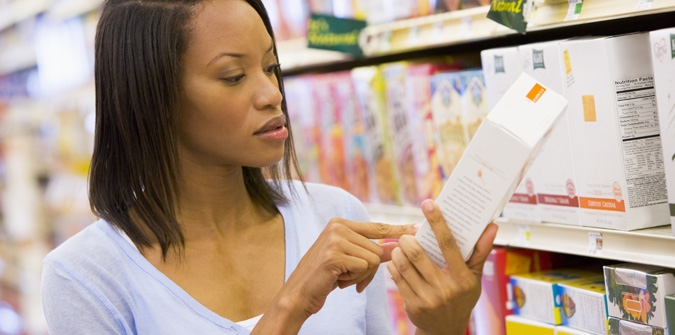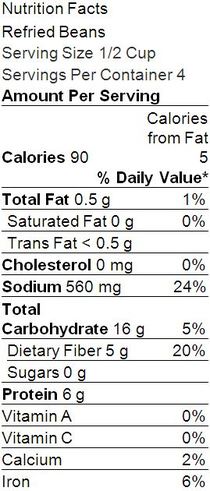Understanding USA food labels
Understanding food labels is really important when you are choosing pre-packaged foods or drinks. Reading the labels means that you can make a better informed choice about the foods you are buying. This will help you to decide if the product is a healthful choice.
Ingredient list
Firstly check out the ingredient list. They are listed in descending order according to the weight of the ingredient used in the product. For example, the largest ingredient used in this product is cooked pinto beans. If sugar is high on the list you know that the product is likely to be high in sugar, or if cream or butter is listed as one of the first ingredients this will indicate it is probably a high fat product. You can also use the ingredient list to look for any ingredients you wish to avoid, such as hydrogenated fats.
Ingredients:Refried Beans: Cooked Pinto Beans, Water, Salt, Tomato Paste, Partially Hydrogenated Lard, Onion Powder, Spice, Chilli Pepper, Garlic Powder
Nutrition Facts Label
The Nutrition Facts Label tells you how many calories and grams of nutrients including total, saturated and trans fat; cholesterol; sodium; carbohydrate; fiber; sugar; and protein are in one serving of the product. It’s important to note whether the serving size on the label is the amount you usually eat. If you usually eat twice the amount noted on the label, you will also consume twice the calories and nutrients listed.
Ingredient list
Firstly check out the ingredient list. They are listed in descending order according to the weight of the ingredient used in the product. For example, the largest ingredient used in this product is cooked pinto beans. If sugar is high on the list you know that the product is likely to be high in sugar, or if cream or butter is listed as one of the first ingredients this will indicate it is probably a high fat product. You can also use the ingredient list to look for any ingredients you wish to avoid, such as hydrogenated fats.
Ingredients:Refried Beans: Cooked Pinto Beans, Water, Salt, Tomato Paste, Partially Hydrogenated Lard, Onion Powder, Spice, Chilli Pepper, Garlic Powder
Nutrition Facts Label
The Nutrition Facts Label tells you how many calories and grams of nutrients including total, saturated and trans fat; cholesterol; sodium; carbohydrate; fiber; sugar; and protein are in one serving of the product. It’s important to note whether the serving size on the label is the amount you usually eat. If you usually eat twice the amount noted on the label, you will also consume twice the calories and nutrients listed.
* Percent Daily Values are based on a 2,000 calorie diet. Your daily values may be higher or lower depending on your calorie needs.
The Percent Daily Values or %DV section is a guide to how nutrients in the food contribute to your overall diet, and also lists vitamins A and C and the minerals calcium and iron (and sometimes others). This section is useful because it helps you choose foods high in nutrients you want to eat more of (such as vitamins, minerals, and fiber) and low in nutrients to eat less of (including sodium, cholesterol, and all types of fat). To make this easier, the nutrients to eat less of are grouped near the top and those to eat more of are at the bottom.
Interpreting % Daily Value
As a guide, if a food contains 20% Daily Value or more of a particular nutrient it is high in that nutrient. This is beneficial if it is one you want to eat more of, such as iron, but not if it is something to eat less of, such as sodium. If the food contains 5% Daily Value or less of a nutrient it is low in that nutrient.
For example, the Nutrition Facts Label for refried beans, above, shows that one serving contributes a valuable amount of fiber (20% Daily Value) and is low in fat at just 1% Daily Value. However it also contains a high 24% Daily Value of sodium, a nutrient to eat less of. This is almost a quarter (25%) of the total daily recommended intake for sodium.
One last point to consider: the % Daily Values are based on a 2000 calorie diet. Your personal Daily Values will be lower for some nutrients if you require less calories than this and higher if you are very active.
The Percent Daily Values or %DV section is a guide to how nutrients in the food contribute to your overall diet, and also lists vitamins A and C and the minerals calcium and iron (and sometimes others). This section is useful because it helps you choose foods high in nutrients you want to eat more of (such as vitamins, minerals, and fiber) and low in nutrients to eat less of (including sodium, cholesterol, and all types of fat). To make this easier, the nutrients to eat less of are grouped near the top and those to eat more of are at the bottom.
Interpreting % Daily Value
As a guide, if a food contains 20% Daily Value or more of a particular nutrient it is high in that nutrient. This is beneficial if it is one you want to eat more of, such as iron, but not if it is something to eat less of, such as sodium. If the food contains 5% Daily Value or less of a nutrient it is low in that nutrient.
For example, the Nutrition Facts Label for refried beans, above, shows that one serving contributes a valuable amount of fiber (20% Daily Value) and is low in fat at just 1% Daily Value. However it also contains a high 24% Daily Value of sodium, a nutrient to eat less of. This is almost a quarter (25%) of the total daily recommended intake for sodium.
One last point to consider: the % Daily Values are based on a 2000 calorie diet. Your personal Daily Values will be lower for some nutrients if you require less calories than this and higher if you are very active.


